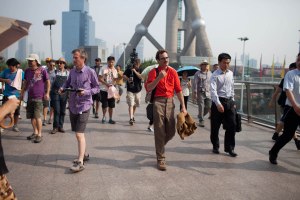
Update: Of course I’m not the only one to get upset about Her’s Los Angeles.
Her is a movie as we know about a near future where interactions with operating system helpers, our “OS”es, displace those with our fellow humans, until they have no more use for us. This line of thinking, which runs from the Velveteen Rabbit to I, Robot, is well trod, and Spike Jonze adds a well-thought-out story to the canon.
What I found more fascinating than the CHI (computer-human interface) plot was Jonze’s depiction of the future of Los Angeles. Having just seen Thom Andersen’s critical film, Los Angeles Plays Itself, about the credibility gap between Los Angeles’s ever-widening economic inequality over the last 70 years and its portrayal in Hollywood film, walking into Jonze’s 21st century Southern California is an even more disorienting and disquieting experience.
Our hero, Theodore Twombley, lives in Beverly Wilshire City (a proxy for Los Angeles’s westside) and works either there or in a simulacrum of Downtown Los Angeles (the One Wilshire building and other towers still standing in this near future). These cityscapes bleed together, so that from higher up there is a vision of Sao Paulo-like skyscapers that extend to the mountains and to the sea. Gleaming highrises are linked by windswept, uncrowded elevated walkways. Along these paths are gaudy security cameras mounted on every lamppost. By 2060 or whenever, the clunky-looking camera mounts would most likely be a thing of the past, so I guess these are here to assure the public that the L.A.P.D. has things under strict control.
There is no garbage on these “streets”. Even entrances to the subway seem clean and efficient, with a steady stream of nearly-all-white knowledge workers moving to and fro. The subways run quietly and happily everywhere (the happy Los Angeles Metro map of the future has already been posted on today’s internet for the curious), and bullet trains can take our workers on vacation to Donner Pass for the weekend.

The people who live and work here are predominantly white and well-educated. There is one scene where a dapper black man busks with a fedora upturned for tips, and a split-second shot of a middle-aged woman sweeping the floors of Beverly Wilshire City while Theodore is not feeling too well about his inevitable break-up with his OS. And while Samantha is being given a early tour of the variety of humans who live here through Theodore’s iPhone camera, we do see one or two Latinos.
The rest are all white hipster or post-hipster young and middle-aged types. They work in what seem to be low-stress, high-paying creative endeavors, letter-writing or game-designing. And they have all gone to or talk about “Harvard”, “magna cum laude”; they strive to become the “class mom”, and if they are not lucky enough to get one of these sweet creative jobs, they can at least work as “lawyers”, so that’s OK. Luckily we can check off that there is no gender inequality in Her L.A. Theodore’s brilliant PhD ex-wife was raised in a household of “high expectations”, he tries to date a Harvard woman with an incredible CV, and so on.
These lucky folk spend their days in workplaces colored by Deborah Sussman in pastel, so that cube workers are always seeing things through rose-colored glasses. People eat well, remembering to chew their fruit for the fiber (if you want to juice anything, juice the vegetables). They wear sustainable fabrics in unpretentious styles (lots of sweaters and J. Crewish colored shirts).
They sport overly large messenger bags (Amy Adams’s is especially big) or gym bags or backpacks, and talk blithely to each other or to their OS through earpieces. There are no dramas beyond those of sexual tension and marriage; apparently no one lacks for money.
What we don’t see is what happened to the 12 million or so Southern Californians who didn’t go to Harvard or didn’t become lawyers. I expect that they have been sent over those mountains to the desert and for the few who are employed as moppers, they can take the bullet trains to work 100s of miles away.
You have to wonder whether Jonze is consciously mocking such a future for Los Angeles or accepting it as the positive end result of the marriage of capitalism and technology. His is a surfer’s dream world, always looking on the positive sunny side of things, a day at the beach of the Emerald City without any economically-depressed denizens.
And I wonder if the beauty and navel-gazing aspect of the whole thing (even the OSes are expert self-analysts following the precepts of Alan Watts) has been tamely accepted by the Hollywood Industry, the folks whose children go to Harvard Westlake school and do actually yacht out to Catalina for a picnic away from the masses on a regular basis.
Thom Andersen had an interesting insight into the environment presented in Blade Runner. Where most viewers saw it as menacing, Andersen delights in the fact that the Los Angeles streets in Blade Runner are filled with real people, density and there are shops and interaction going on.
The surroundings of Her are scarily too similar to where I sit in Kentfield. The “class mom” game is being played out for real every day here, and the one percent meet in quiet cafes to talk about their marital problems; the rest of society (poverty, under-education, a future without the promise of work) is hard to see.

Hello Peter,
I haven’t seen the movie. I got the concept just watching the trailer. I wonder if you saw this article in the NYT last week. http://www.nytimes.com/2014/04/10/us/report-finds-a-los-angeles-in-decline.html?&assetType=nyt_now
Regards,
Alan